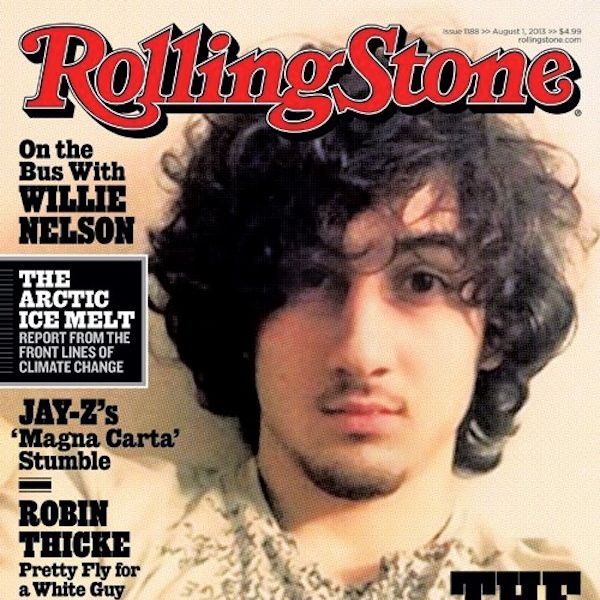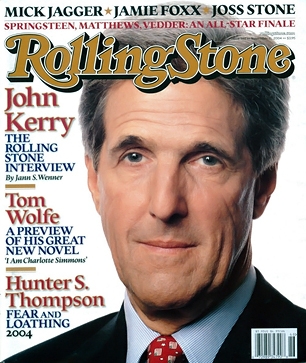The Real Trouble with the Dzhokhar Tsarnaev Rolling Stone Cover
The internet is overrun with outrage that Rolling Stone put a glamour shot of alleged Boston marathon bomber Dzhokhar Tsarnaev on their cover. Here are three representative pieces of feedback from Rolling Stone‘s “fans” on its Facebook page:
- “Very un-American. Fuck you Rolling Stone. I thought it was supposed to be an honor to be on your cover?”
- “The media…including Rolling Stone…has lost all notions of honor in the value of making a buck.”
- “Why the f***k would you EVER consider putting that bastard on the cover? ARE YOU INSANE?”
Rolling Stone has clearly made a gross miscalculation here, but in each of these, uh, passionately delivered critiques are some misconceptions about just why. On the question of whether it’s an “honor” to be on the cover of Rolling Stone: A lot people seem to forget that Rolling Stone, while known for its music coverage, also contains harder news, and sometimes that news makes their cover. They put Charles Manson there in 1970 to tease an interview they scored with him in prison, even though he’s, you know, Charles Manson. The story won a National Magazine Award. Since then, they’ve often put aside the usual celebrity cover format to feature a newsy subject, not because it’s an honor, but because it was the subject of a story or interview they wanted readers to see.
As for whether putting Tsarnaev on the cover was a ploy to “make a buck,” you can bet the editors know that if they’re looking to increase newsstand sales, they’re better off just getting those teen vampires from “True Blood” to pose naked again. People buy magazines with the faces (and naked bodies) of people they recognize and like. Condé Nast’s best selling magazine, for instance, isn’t The New Yorker, though its cover often has witty takes on hard news. It isn’t even Vogue, though it often has beautifully shot celebrity photography. It’s Glamour, whose cover features One Direction this month. If Dzhokhar Tsarnaev was Rolling Stone‘s ploy to make money, it doesn’t seem like a very well considered one.
As for whether he should be on the cover of a magazine at all, let’s suggest that the problem here isn’t that they put Tsarnaev on the cover persay, but that they chose a photo that doesn’t differentiate him from the rest of their glamorous celebrities. Many have suggested that the cover evokes Jim Morrison.
New Rolling Stone cover turns the Boston bomber into Jim Morrison. A comparison: pic.twitter.com/UJKhAMJSGO
— Judd Legum (@JuddLegum) July 16, 2013
Much as we’d like to, we can’t simply ignore Tsarnaev for the rest of time. He hasn’t even stood trial, and he’s a reasonable subject for journalistic inquiry. In general, we should allow magazines that cover news, as Rolling Stone does, to put evil people on their covers, especially if they’re teasing journalism that merits it and furthers the story. (It’s worth noting that no one has actually read the article that will accompany this cover by contributing editor Janet Reitman. The magazine says it will be deeply reported, and maybe it will be.) The editors probably didn’t want to choose a grainy surveillance photo of Tsarnaev, since that’s sort of outside their aesthetic. But perhaps they could have gone the same route taken by The Week, which asked almost the exact same question of Tsarnaev—How did Dzhokhar become so radical?—on its cover without inspiring a tarring and feathering on Boston Common. The difference: they depicted him with a cartoonish illustration.
And lest you think the cartoony route wouldn’t fit with Rolling Stone‘s aesthetic either, recall how they often depicted another cover subject for whom they didn’t harbor much goodwill: George W. Bush.
Other publications used the same photo of Tsarnaev to illustrate much the same point that Rolling Stone‘s cover line makes: he didn’t seem, to those who knew him, like a mass murderer.
That Dzhokhar selfie on the Rolling Stone cover was everywhere at the time. It was on the front page of the Times! pic.twitter.com/ix0KreMst7
— Stefan Becket (@stefanjbecket) July 17, 2013
But Rolling Stone just has to be more sensitive to the context their magazine gives that photo. The point here is that Rolling Stone does occasionally important and award-worthy journalism about non-musical subjects, and perhaps they’ve done so again. The problem is that no one looking at the Boy Band member-cum-terrorist they’ve put on the cover this month would know it. And that, as people say, gives him undue glory and in the worst case, might provide inspiration to those who’d seek infamy by whatever horrible means possible. Rolling Stone could have gotten away with a cover devoted to Dzhokhar Tsarnaev. They just couldn’t get away with this cover.







